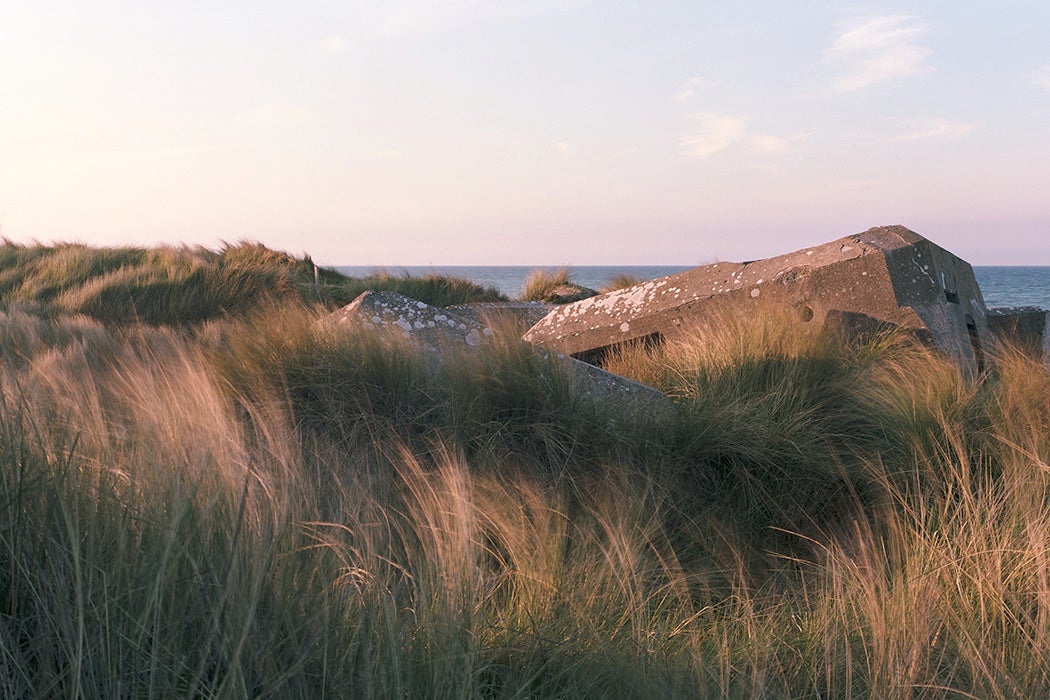One would think that the military history of World War II is well-covered territory. But we’re now long enough away from those events that the application of archaeological methods can reveal new things and revise the record. The forests of Normandy are a case in point.
“Normandy’s forest environments—the preferred location for German supply depots—have the potential to host not only the remarkably well-preserved archeological landscapes of such depots, but also the bomb craters intended to destroy them,” write David Capps Tunwell, David G. Passmore, and Stephan Harrison.
Capps Tunwell, Passmore, and Harrison explain that an archaeological survey of WWII remains in Normandy’s Forêt domaniale des Andaines (Andaines National Forest) has “prompted an evaluation of the effectiveness of Allied intelligence gathering and tactical bombing” before and after the D-Day invasion of June 6, 1944. It turns out that neither intelligence nor bombing seem to have been particularly effective against supply depots hidden in the forest. The evidence: bunkers, other ruins, and craters, left alone for decades by minimally invasive forest-management practices.
Operation Overlord, the Allied invasion of Nazi-occupied western Europe, was a highly fraught endeavor. The first troops to come ashore—and, further inland, be parachuted or landed in flimsy gliders—were outnumbered. They had to gain beachheads, get off the beach as soon as possible, and move in force inland as quickly as possible. Airborne troops meanwhile had to hold key bridges and causeways inland until seaborne troops met up with them. All the while, supply lines reaching back to the beaches, and from there across the English Channel, had be kept open for more troops and materiel.
Luckily, the Allies largely controlled air space. Air attacks on German army (Wehrmacht) vehicles and French infrastructure “were significant in disrupting German efforts to both reinforce and supply combat troops,” write Capps Tunwell, Passmore, and Harrison. But attacks against the network of supply depots and ammo dumps were much less so. Well into August, the Wehrmacht was “at least adequately sustained from nearby supply dumps.”
An army marches on its stomach, declared Frederick the Great and/or Napoleon Bonaparte. In WWII, armies also moved on gasoline. POL depots, named after the petrol, oil, and lubricants they stored, were a particular source of concern to the Allies. Panzer units could have punched back the invasion, with the requisite fuel, munitions, and parts to keep them going.
Intelligence about the location of forest depots came from “Ultra decrypts, photo-reconnaissance, PoW interrogations, and updates from air and ground forces” including French Resistance members and units of the British Special Air Service (SAS), and American Office of Strategic Services (OSS).
But forests are great cover. Translating intelligence into bombing targets and then finding those targets from the air over featureless expanses of trees proved to be a challenge. The US Ninth Air Force’s assessments of their own bombing runs on depots in the Forêt domaniale des Andaines in June found that only 40 percent of the bombs dropped landed on target areas (and those were the best case examples). One of the largest Wehrmacht munitions depots in the vicinity of D-Day beaches, called Lager Martha, was not targeted at all. The remains of the facility today show no bomb cratering. The facility remained in operation until overrun by American troops on August 14, just five days before Allied troops entered Paris.
Capps Tunwell, Passmore, and Harrison note that only 10 percent of the tactical bombing in Normandy, as measured by tonnage, targeted supply dumps in June and July during the Battle of Normandy. To give a sense of the scale of air operations, this amounted to 4,778 aircraft sorties.
Weekly Newsletter
Allied air attacks on supply depots weren’t useless. For instance, almost 80,000 gallons of fuel were destroyed in an air raid on June 13. Overall, however, airpower was much more successful in hindering Nazi communication infrastructure and “demotorizing” the Wehrmacht. Already fighting defensively on two other fronts, the Nazi war machine, once so vaunted for its mechanized forces, couldn’t muster enough trucks in France.
Missing a lot of the Wehrmacht supply infrastructure in Normandy slowed down the Allied cause and caused more casualties, but didn’t stop the juggernaut heading toward Germany.
Three Tips for Teaching:
Provide context with oral histories and memoirs: Read Eugene Pendleton Banks’s recollections of his participation in Operation Neptune, the naval component of Operation Overlord, courtesy of the Wake Forest Faculty in World War II collection via JSTOR.
Explore primary sources:
- The English-language newspaper Amrita Bazar Patrika, available in the South Asian Open Archives via JSTOR, carried news of the battles in northern France to readers in Calcutta.
- The United States Naval Academy has made available almost 1,500 documents and images related to World War II via JSTOR, including a bulletin on supporting operations for the invasion of northern France, June 1944, that “must not fall into enemy hands.”
Support JSTOR Daily! Join our membership program on Patreon today.







